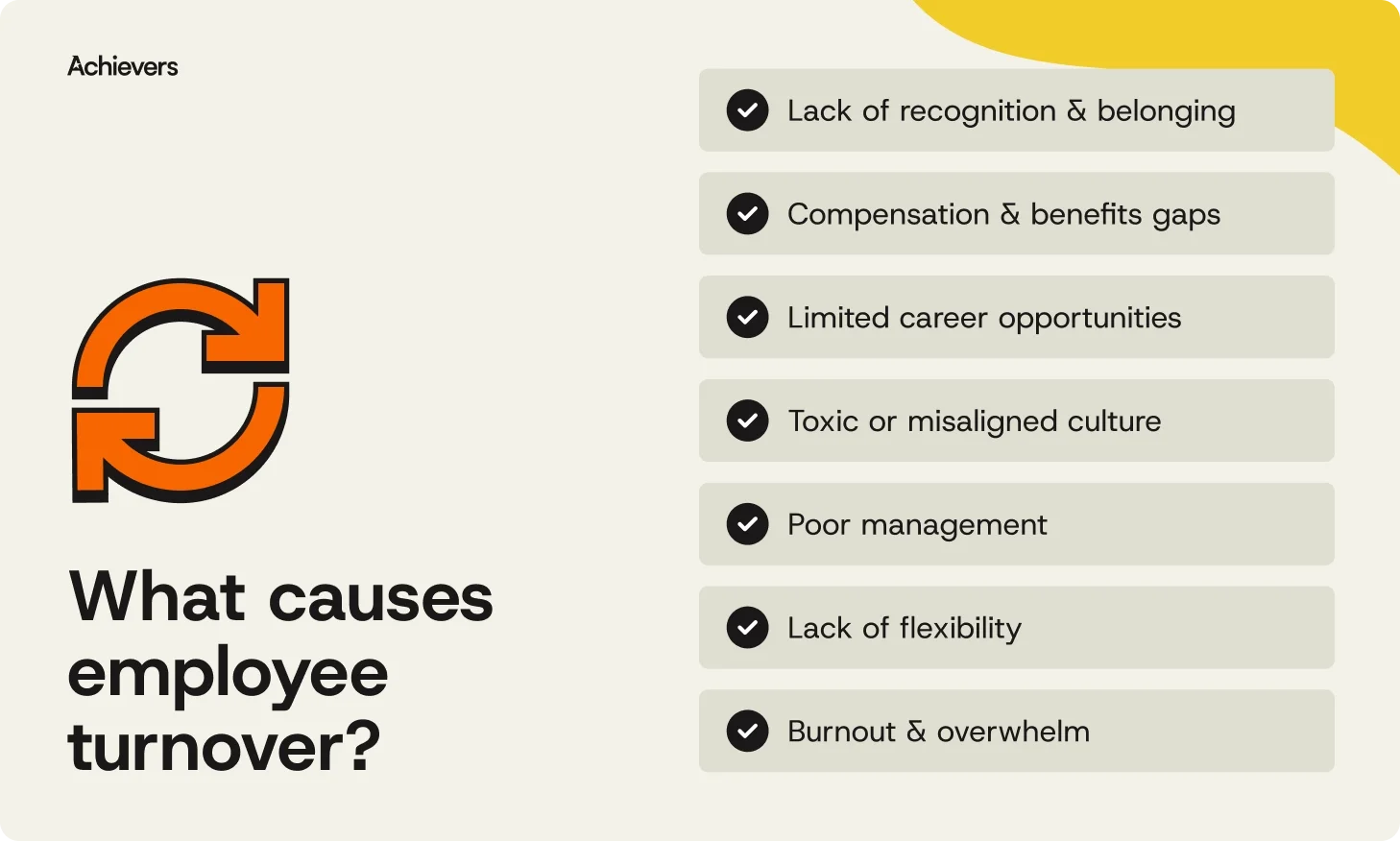Table of contents
Create a culture that means business™
Schedule a demo with an Achievers solution expert today.
Employee turnover is a reality every company faces — people leave, new employees come in. Simple enough, right? Not quite.
When turnover climbs, it doesn’t just mean a few exit interviews and job postings. It means lost productivity, strained culture, and costs that can soar to more than 200% of a manager’s salary, according to Gallup. That’s a pricey revolving door.
The good news is turnover isn’t just something you track — it’s something you can change. And understanding why it happens is the first step to keeping your best people where they belong: with you.
What is employee turnover?
Employee turnover is the rate at which employees leave your company — whether they resign, retire, or are let go — and need to be replaced. Some turnover is expected, but when talented people choose to leave, the impact runs deeper than an open role. It means losing hard-won skills, disrupting team momentum, and starting over with recruiting and onboarding employees.
That’s why turnover isn’t just an HR metric. It’s a reflection of culture and leadership — and if it’s too high, it’s a signal your business can’t afford to ignore.
What causes employee turnover?
Turnover rarely comes down to one factor. It’s usually a mix of unmet needs, poor experiences, and missed opportunities. Here are the most common reasons employees decide to move on — and what organizations can do to stop it:

1. Lack of recognition and belonging
When people feel invisible, they don’t stick around. The State of Recognition Report shows that 53% of employees are recognized only a few times a year or less — hardly enough to make them feel valued. But when employees are recognized at least once a month, 91% say they would put in more effort. Genuine appreciation leads to belonging — and without it, don’t be surprised when your best people start eyeing the exit.
2. Compensation and benefits gaps
Pay isn’t everything, but it’s the baseline. If salaries and benefits don’t match market expectations or workload, employees will notice — and recruiters will come calling. Pay transparency is key. Get it wrong, and even the most engaged employees may trade loyalty for a better offer.
3. Poor management
The old saying still holds: people don’t leave companies, they leave managers. Leaders who micromanage, fail to listen, or don’t provide support create a disengaging environment. The result? Lower morale, less trust, and employees who start polishing their résumés.
4. Limited career opportunities
Ambitious employees want a future with you — if they don’t see one, they’ll find it somewhere else. But research from the Skills Gap Report found that employees who rate their company’s internal mobility program as excellent are 26% more likely to say they wouldn’t consider changing jobs in the next year. It couldn’t be clearer: providing growth and development opportunities is one of the most effective ways to reduce turnover.
5. Burnout and overwhelm
Heavy workloads, unclear roles, or constant pressure lead to chronic stress. And burnout doesn’t just push employees out — it drags performance down long before they leave. Protecting work-life balance, prioritizing well-being, and setting realistic expectations are critical to keeping employees healthy and engaged.
6. Toxic or misaligned culture
Culture can be a magnet or a repellent. When values on the wall don’t match daily reality, employees notice. A lack of psychological safety, misaligned priorities, or unhealthy workplace politics create friction that sends people packing. Culture is your retention strategy.
7. Lack of flexibility
Rigid schedules and outdated policies no longer cut it. Flexibility in when and where people work gives them autonomy and trust — both proven engagement drivers. Without it, turnover risk spikes, especially in competitive industries where remote or hybrid options are the norm.
The true costs of turnover
Turnover isn’t just a line on an HR report — it’s expensive, disruptive, and frustratingly avoidable. The cost of turnover adds up fast, especially when you factor in not just the checks you’re writing, but the ripple effects you can’t always see.
Direct costs: recruiting, onboarding, training
Every departure triggers a string of expenses. Posting jobs, paying recruiters, and pulling managers into interviews all add up — and that’s before a new hire even starts. Once they do, weeks (or months) of onboarding and training follow, while productivity lags. In other words, the meter starts running the moment someone gives notice, and it doesn’t stop until their replacement finally finds their rhythm.
Indirect costs: morale, culture damage, lost productivity
The bigger hit often comes from what you can’t put neatly into a spreadsheet. When employees leave, projects slow down, remaining team members shoulder extra work, and productivity drops. Morale takes a hit, too — high turnover makes people wonder if they should be next. It has a way of turning a great workplace into one everyone’s trying to leave.
How to calculate employee turnover
Calculating turnover gives you a powerful snapshot of how healthy your workforce really is. Here’s how it works:
- Count the departures: total number of employees who left during the period (monthly or annually).
- Find your average headcount: add the number of employees at the start and end of the period, then divide by two.
- Do the math: divide departures by average headcount, then multiply by 100.
Formula:
Example:
If 5 employees left over the year and your average headcount was 80:
It’s simple math with serious implications. Track it regularly, and you’ll spot whether turnover is a healthy refresh or a sign of trouble.
How to lower employee turnover: Workplace solutions
Employee turnover isn’t a problem you solve once. It’s a challenge you manage every day. The good news? Preventing it doesn’t require flashy perks or complicated programs. It comes down to consistent, people-first practices that make employees want to stay.
Here are six solutions every employer can put into play:
Recognize employees frequently and meaningfully
Recognition is one of the simplest ways to keep employees from walking out the door. And it works — employees recognized weekly are three times more engaged than those recognized once a year. The fix isn’t complicated: say thank you more often and mean it. Simple prompts — like a recognition checklist — can help make consistency second nature. Turns out, loyalty doesn’t always need a big budget, just a little attention.
Listen and act on employee feedback
Exit interviews are too late. Feedback has to be continuous if you want to lower turnover. Always-on programs, like Achievers’ Voice of Employee solution, give teams a way to share input in real time — and managers a clear path to act on it. Because nothing builds trust faster than proving you were actually listening.
Develop great managers
People may join a company, but they leave managers. Poor leadership pushes top performers to the exits faster than compensation ever could. Coaching, training, and the right employee feedback tools help leaders show up better for their teams. When managers model appreciation and support, employees tend to stick around (funny how that works.)
Support growth and career development
Nobody wants to feel stuck. When employees can’t see a future with you, they’ll create one somewhere else. Mentorship, training opportunities, and clear career paths send a different message: you don’t need to leave to move up. Growth doesn’t just keep people longer — it makes them better while they’re here.
Prioritize well-being and work-life balance
Experiencing burnout at work is the fastest track to turnover. And no, free snacks won’t cut it. What helps? Flexibility, realistic workloads, and visible support for mental health. When people feel trusted to manage their time and energy, they’re not just more engaged — they’re a lot less likely to update their LinkedIn profiles on a Tuesday night.
Build cultural alignment and belonging
Culture shows up in everyday moments, not in posters on the wall. When recognition is tied to company values, it makes culture real. Pair that with DEIB initiatives, and every employee can feel like they truly belong. When culture and daily experience actually match, people stop scanning job boards and start picturing themselves building a career with you.
Reduce turnover with recognition, rewards, and real results
Turnover doesn’t have to drain your culture or your budget. With Achievers, recognition and employee voice work together to keep people engaged and performing at their best.
From the world’s largest rewards marketplace to always-on feedback and AI-driven insights, our platform helps you reduce turnover where it starts — with your people.
Turnover rate = (employees who left ÷ average employees) × 100
(5 ÷ 80) × 100 = 6.25% turnover



